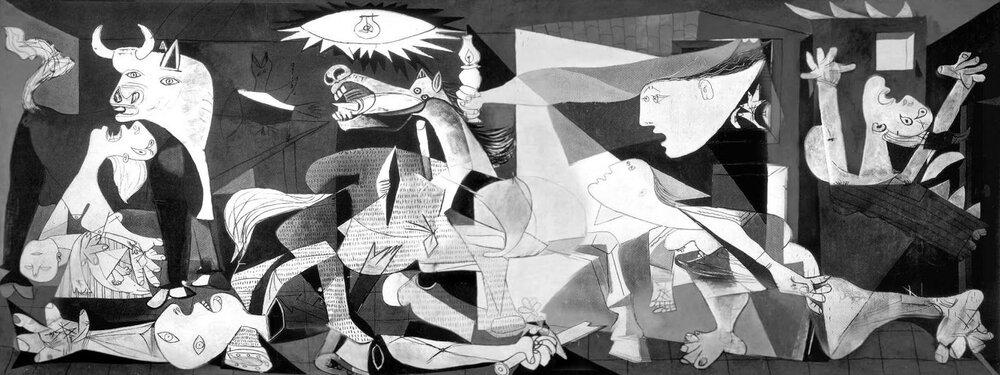Introduction
Guernica is a painting created by Pablo Picasso in 1937 as a response to the bombing of the eponymous town in northern Spain. The artistic movement represented by this work is Cubism; however, the painting also incorporates elements of Surrealism. As an artist, Picasso is a unique figure in the Cubist movement, often regarded as its pioneer. Many scholars and art historians have discussed The transformative influence of Picasso and Cubism on the course of art history (Wedderburn, 2019). Having emerged in 1907 in France, the movement developed as a response to a rapidly changing world where technology was increasingly gaining power. Ultimately, Guernica was an art piece that reflected the changes in the art world, further expanding the influence of Cubism, which soon became popular due to its creative ideas and techniques.
Historical Context of Guernica

Historical and political events that preceded the creation of Guernica (see Figure 1) were the factors that most influenced Picasso’s decision to make this anti-war painting. Initially, Picasso was given a commission to create a mural for the Spanish Republic’s Pavilion at the 1937 World Fair in Paris, where he was living at the time (Wedderburn, 2019). Since Picasso was apolitical, he refused to do it; however, after he read about the bombing of Guernica on April the 27th, he decided to devote the mural to the victims of this tragic event. The devastating images he saw in the newspapers horrified him, and he frantically began painting the mural, finishing it in just three weeks (Reisch, 2019). The speed with which Picasso was working can still be seen in the painting in many splashes and strokes that add to the feeling of frustrating urgency.
Art Style and Stylistic Influences
Various stylistic influences and inspirations can also be seen in this work. One of the artists loved by Picasso was Peter Paul Rubens, and his works, such as An Allegory Showing the Effects of War inspired many of the choices Picasso made while creating Guernica (Reisch, 2019). Some of the similarities can be seen in the composition of these two paintings; these similarities are even more obvious if Rubens’ painting is flipped so that the characters are presented from left to right (Arranz Otaegui & Moore, 2022). In this way, both works depict a weeping woman holding a child, a flying fury of war, and another woman looking at the sky and stretching her arms towards it. Thus, Picasso was influenced by allegorical paintings and used these inspirations to create Guernica.
Interestingly, Guernica was not inspired by any of the real scenes or visual references to the events and victims of the bombing. Instead, Picasso was mostly influenced by the fictitious scenes from his early works and other artists’ paintings that evoke the suffering and death associated with all wars (Arranz Otaegui & Moore, 2022). Using these influences and his own inspirations, he managed to reinvent the genre of historical painting and create what has arguably become the most well-known anti-war painting.
Conclusion
This research has significantly enhanced my appreciation of Picasso’s artwork as I have learned more about the historical background of its creation. Understanding the context of this work helped me to interpret it in a variety of new ways. I have realized that all the decisions that were a part of Picasso’s work on this painting somehow add to its main intent: an anti-war message. For example, by creating and composing the scene in this seemingly chaotic manner, Picasso evokes the horrifying confusion and madness of all wars. In addition, the use of black, white, and gray colors conveys the darkness and hopelessness of wartime. Ultimately, Guernica by Pablo Picasso is one of the most significant art pieces in Cubism that takes inspiration from historical and stylistic influences.
References
Arranz Otaegui, I., & Moore, K. C. (2022). Visual art and propaganda ecologies in the Basque country: A sample of Guernica motifs from the Benedictine Sticker archives (1978–1989). Arts, 11(3), 62.
Guernica by Pablo Picasso. (n.d.). Emptyeasel. Web.
Reisch, A. (2019). Art and humanisum Picasso’s guernica. The Australian Humanist, 136(2), 18. Web.
Wedderburn, A. (2019). The appropriation of an icon: Guernica, remade. International Feminist Journal of Politics, 21(3), 480–487.